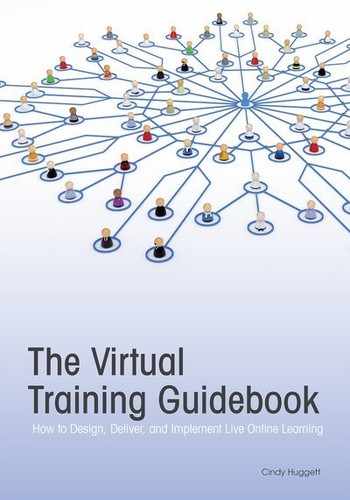Akamai. (2013). “State of the Internet Report.” www.akamai.com/stateoftheinternet/.
ASTD. (2012). Mobile Learning: Delivering Learning in a Connected World. Alexandria, VA: ASTD Press.
ASTD. (2012). State of the Industry. Alexandria, VA: ASTD Press.
ASTD. (2009). The Value of Evaluation: Making Training Evaluations More Effective. Alexandria, VA: ASTD Press.
Babson College. (2012). “2012 Survey of Online Learning” Babson College, www.babson.edu/news-events/babson-news/pages/130107-2012-survey-of-online-learning-results.aspx.
Baker, C. (2010). “The Impact of Instructor Immediacy and Presence for Online Student Affective Learning, Cognition, and Motivation.” The Journal of Educators Online, volume 7, number 1.
BBC News. (2008, May 30). “Formula ‘Secret of Perfect Voice.’” BBC News, http://news.bbc.co.uk/2/hi/uk/7426923.stm.
Broad, M.L., and J.W. Newstrom. (1992). Transfer of Training: Action-Packed Strategies to Ensure High Payoff From Training Investments. Reading, MA: Addison-Wesley.
Chief Learning Officer. (2012, December 13). “Survey: Most Plan to Increase Virtual Learning in 2013.” Chief Learning Officer, Solutions for Enterprise Productivity, http://clomedia.com/articles/view/survey-most-plan-to-increase-virtual-learning-in-2013.
Christopher, D. (2012, February 1). “Keeping Participants’ Attention in Global Virtual Classrooms,” http://www.astd.org/Publications/Newsletters/Learning-Circuits/Learning-Circuits-Archives/2012/02/Keeping-Participants-Attention-in-Global-Virtual-Classrooms. Adapted from “Facilitating in the Global Virtual Classroom,” Infoline No. 1111 (November, 2011). Alexandria, VA: ASTD Press.
Clark, R.C., and A. Kwinn. (2007). The New Virtual Classroom. San Francisco: Pfeiffer.
Courville, R. (2012) Survey conducted via website, www.thevirtualpresenter.com.
Covey, S. (1989). The 7 Habits of Highly Effective People: Powerful Lessons in Personal Change. New York: Free Press.
Dirksen, J. (2012). Design for How People Learn. Berkeley, CA: New Riders.
Eddy, N. (2012, January 6). “Mobile Worker Population to Reach 1.3 Billion by 2015: IDC.” eWEEK, www.eweek.com/c/a/Mobile-and-Wireless/Mobile-Worker-Population-to-Reach-13-Billion-by-2015-IDC-238980/.
Ellis, R.K. (2012, December 5). “Accenture Study Details Digital’s Disruptive Impact on Workforce in Southeast Asia” www.astd.org/Publications/Blogs/Global-HRD-Blog/2012/12/Accenture-Study-Details-Digitals-Disruptive-Impact-on-Workforce-in-Southeast-Asia.
ESPN. (2010). “John Wooden’s Greatest Quotes.” ESPN: The Worldwide Leader In Sports, http://sports.espn.go.com/ncb/news/story?id=5249709.
Falloon, G. (2011, December). “Exploring the Virtual Classroom: What Students Need to Know (and Teachers Should Consider).” Journal of Online Learning and Teaching, volume. 7, number 4.
Gartner Research. (2013, May 1). “Gartner Predicts by 2017, Half of Employers Will Require Employees to Supply Their Own Device for Work Purposes.” Technology Research, Gartner Inc., www.gartner.com/newsroom/id/2466615.
Huggett, C. (2010). Virtual Training Basics. Alexandria, VA: ASTD Press.
Jacobs School of Engineering. (2013, January 30). “Working Alone Won’t Get You Good Grades.” UCSD Jacobs School of Engineering, www.jacobsschool.ucsd.edu/news/news_releases/release.sfe?id=1308.
Jaschik, S. (2009, June 29). “The Evidence on Online Education.” Inside Higher Ed, www.insidehighered.com/news/2009/06/29/online.
Kalman, F. (2011, October). “Training is Essential for Successful Telework Management.” Chief Learning Officer magazine, http://clomedia.com/articles/view/flexible-work-arrangements-require-clo-involvement-to-shift-mindsets/3. (Original research from Dieringer Research Group and WorldatWork.)
Kirkpatrick, D.L., and J.D. Kirkpatrick. (2006). Evaluating Training Programs: The Four Levels (3rd edition). San Francisco: Berrett-Koehler.
Laird, D. (1985). Approaches To Training And Development (2nd ed.). Reading, MA: Addison-Wesley.
Landry, L. (2013, January 8). “Over 6.7 Million Students Are Now Taking Classes Online.” Bostlnno, http://bostinno.com/2013/01/08/2012-babson-survey-of-online-learning-6-7-million-students-taking-classes-online/#ss__281086_1_0__ss.
Martin, F., M.A. Parker, and D.F. Deale. (2012). “Examining Interactivity in Virtual Classrooms.” The International Review of Research in Open and Distance Learning, volume 13, number 3, www.irrodl.org/index.php/irrodl/article/view/1174/2253.
Medina, J. (2008). Brain Rules. Seattle: Pear Press. (2010).
Mervis, J. (2011, May 12). “A Better Way to Teach?” Science, http://news.sciencemag.org/sciencenow/2011/05/a-better-way-to-teach.html.
Mina, A. (2012, October 9). “Virtual Training: Tips to Reduce Budget Without Sacrificing Engagement.” GP Strategies, http://blog.gpstrategies.com/learning-content/virtual-training-improve-engagement.
Murdoch, M., and T. Muller. (2013). The Webinar Manifesto: Never Design, Deliver, or Sell Lousy Webinars Again. New York: RosettaBooks.
Pike, R.W. (2002). Creative Training Techniques Handbook, (3rd ed.). Amherst, MA: HRD Press.
Pike, R.W. (2011). “Creative Training Techniques for Webinars: Seven Ways to Add Impact and Wow—NOW!” Session presented at ASTD TechKnowledge® 2011 Conference & Exposition, San Jose, CA, February 2011.
Pink, D.H. (2012). To Sell Is Human: The Surprising Truth About Moving Others. New York: Riverhead Books.
Phillips, J.J., and P.P. Phillips. (2007). Show Me the Money. San Francisco: Berrett-Koehler Publishers.
Rossett, A. and R.V. Frazee. (2006). AMA Special Report “Blended Learning Opportunities.” American Management Association.
Shank, P. (2010). “Getting Started with Synchronous e-Learning” The eLearning Guild.
Silverman, R.E. (2012, December 12). “Workplace Distractions: Here’s Why You Won’t Finish This Article.” Wall Street Journal, http://online.wsj.com/article/SB10001424127887324339204578173252223022388.html. (Original research done by Stanford University.)
Towards Maturity. (2011). “Harnessing Live Online Learning: The UK’s First Research Study Into Virtual Learning.” Towards Maturity, www.cloud4training.com.
United States Census Bureau. (2010). 2010 Census Report, www.census.gov/2010census/.
Westerman, G. (2012, April 2). “IT Is From Venus, Non-IT Is From Mars.” Wall Street Journal, page R2.
Wikipedia. (2013). “List of Most Popular Given Names,” http://en.wikipedia.org/wiki/List_of_most_popular_given_names.
